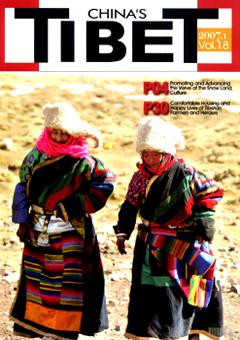COMFORTABLE HOUSING AND HAPPY LIVES OF TIBETAN FARMERS AND HERDERS
PENKYI
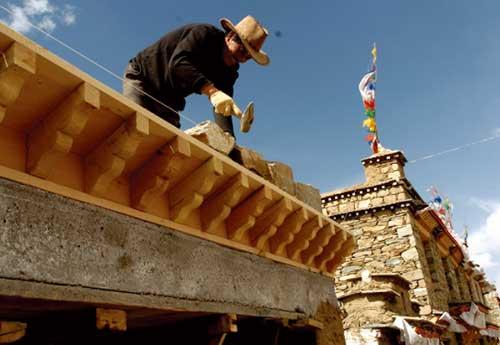
Mar.24th,2006,famers of Dechen Village in Taktse County are busy to build the two floor house by using earth and stone.
In 2006, a hot topic arose in regard to Tibetan economic development. This was the "comfortable housing project".
A range of new houses and enumerable new villages are rising above the ground at accessible sights such as the sides of roads and grasslands close to villages. Beaming smiles are fixed on the faces of farmers and herders while they are moving into new houses. Since the beginning of 2006, Tibet has launched a comfortable housing project to settle herders, transferring living places for the sake of poverty relief, and also renovation of farmers' houses. The project aims to have 80% of farmers and herders living in comfortable houses within five years and build a new socialism in villages all around Tibet. Though only one year has past since launching the project, the remarkable achievements are obvious.
250 Thousand Tibetans Moved into New Houses
Up to October 2006, Tibet has fulfilled its project in which 46,994 houses have been constructed and/or households of Tibetan farmers and herders have been resettled. Currently, total of 250 thousand Tibetans have already moved into their new houses. The project includes renovating 26,220 original houses, re-settling 9574 herders, and moving 6,116 households into new places because of poverty relief. It also includes 4,354 households involved in the project of "reviving and enriching in the frontier areas" and 730 households being moved from areas prone to endemic diseases. The housing project has fulfilled all targets in terms of providing separate accommodation for human beings and domestic animals, providing safe water and sanitation, and generally making big changes in living conditions.
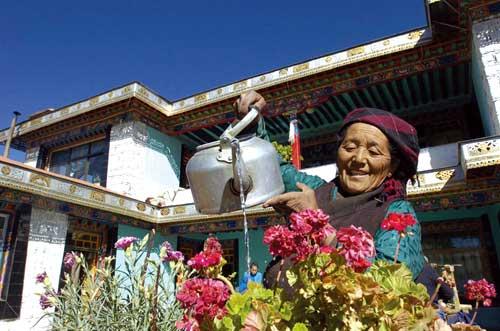
On Jan.2and,2006,Samdrup Drolma,a Tibetan old granny in Cha Village of Nam Township in Chushur County,is watering follwers in her new garden.
With total input of 2.472 billion Yuan in the housing project, 390 million Yuan comes from the government at regional level, the prefecture and county level government added 120 million Yuan and public donations are 75 millions. Money collected from the public totaled 1.444 billion and loans from monetary organizations are 443 millions. In addition, the project on infrastructure construction for water, electricity, road, and telecommunication service system has been accelerated in order to match with the housing project. Since then, the income of farmers and herders has increased constantly. Until the end of September, per capita income all around Tibet has already reached 1646 Yuan, an increase of 13.7% over the same period of last year. The total population able to access safe water has reached 200 millions; 36 thousands of the rural population have been supplied with electricity; the mileage of rural roads has reached 817 kilometers, and paved roads are available in 700 administrative villages.
Dawa, a farmer of Tohlung Dechen County in Lhasa Municipality, organized a ceremony when the roof of his new house was going on. Folks sang songs and cast barley powder to the sky. They prayed for favorable weather for crops and good fortune in the coming year. Following a traditional rite, Dawa and his wife presented white silk scarves and barley wine to constructors. Dawa told the author that after just 18 days the house was almost ready.
Beside the new house is the old one, built four years ago and lived in by four of them sharing one room. The old one is not really safe because it was built with mud. But Dawa chose rocks as key materials for this new one. He said the total cost of the new one was about 60 thousand Yuan, including 10,000 Yuan sponsored by the regional government, 4,000 Yuan from the municipal government, and 10,000 Yuan from the government of Tohlung Dechen County. Dawa said if there was no support from government, it would have been impossible for him to build this.

On Nov.9th,2006,Gyalo,the villager of Kongpo Gyamda Country,
is making buttered tea at her new house.
While visiting Tohlung Dechen County, the author saw many households were busy building their new houses. Last year, the government designated this county as the pilot county for the housing project. The so-called "comfortable housing project" refers to a government project to help people live in safe, comfortable and suitable houses. For two years, a total of 2000 households in Tohlung Dechen County have accomplished the construction of new houses under the support of government. For those self-construction households, they all obtained support totaling 24,000 Yuan donated by government at different levels. Funds sponsored by government are only one aspect - technical support is the other.
Comfortable Housing Project Figures out the Problem of Endemic Diseases
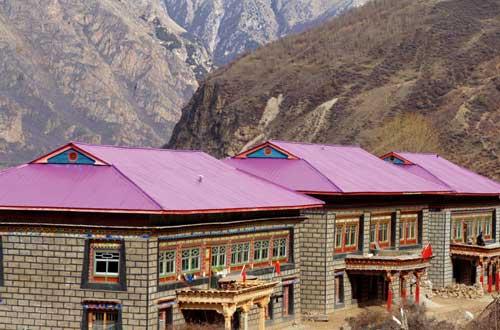
On Nov.9th,2006,a glimpse of Karmo village in Kongpo Gyamda County.
The comfortable housing project not only moves households away from deep mountain valleys, but also solves the problem of endemic diseases that has burdened Tibetans for years.
In early 2006, the author encountered Dekyi, the old granny who was busy moving into her new house, while the author was visiting Jinda Township of Kongpo Gyamda County. Folks in the village are sitting in her light and roomy house drinking yak butter tea and listening to the story of the old granny.
Dekyi is from Chamdul Prefecture. Since she was a small girl, she was a servant of the landlord to take care of sheep and yaks. She escaped after rebelling against oppression from the landlord. Then she walked to Tohlung Dechen County, begging all along the way in order to reach there. After peaceful liberation, Dekyi finally settled down at Jinda Township. She was also allocated her own domestic animals and land as well.
"Today, I am living in new house with a comfortable life. I am so happy. All of my fortunes do not come from my prayers, but rather from the communist party." Since the comfortable housing project was launched in this county, the living standards of Tibetans who originally lived in substandard conditions, has achieved a world-shaking change.
In Xinsheng Village, since the 1950s, over 20 households have been renovated several times, but never changed the situation of living with low ceilings and sunless rooms or sharing a room with domestic animals. Due to polluted water sources, local Tibetans have suffered from Kashin Beck disease and lost their ability to work for some years. Some Tibetans have lost their lives because of these diseases. Currently, 21 households in this village have been moved away from the deep mountain valley to the side of No. 318 National Road and resettled there. Living in capacious and bright new houses with accessibility to electricity and telephone, Tibetans are enjoying watching television programs in their houses. Granny Dekyi told the author: "It is such an easy way. The road is just in front of village. Our lives get better and better. Our families do not need to worry about Kasin Beck diseases any more."
Construction of Villages
Setting up a small downtown area in a village is not a new phenomenon in the suburbs of Lhasa. It is obvious that the new houses of farmers in Tohlung Dechen County are more beautiful than some in Lhasa City. In Dungkar Village, such houses are easily observed. Over 300 Tibetan-style two-storey houses are scattered at random, and cement-paved roads lead directly to their entrances. The village square for multiple activities is big enough for three basketball courts. Every household can gain access to phone, radio, television, a healthy and comfortable environment and solar energy. Many villagers have TV sets with big screens, audio equipment, and computers, even cars. The village leader explained to us that the changes were brought about by the housing project. In the past, village residences were scattered and the structure of their houses was poorly designed. Nowadays, the old-fashioned village has gone and a new one has emerged which is bright, comfortable and modern.
Drolkar, the governor of Tohlung Dechen County told the author that this village has undergone a comprehensive change: renovations or rebuilding of houses, upgrades to water supply, electricity and telephone, improved roads and access to solar energy. All of this is the face of the new village socialism.
The old Changpa in Dungkar Village moved to this village in July 2006. It costs 160 thousand Yuan to build his house of 200 square meters; 80% donated by the government and 20 % from his own funds.
Governor Drolkar said that having a comfortable house like that of Changpa closely relates to the increased development of cities. Tohlung Dechen County is just 10 kilometers away from Lhasa City. The old house of Changpa has been brought into the system as one part of Dungkar district in Lhasa City. His old house was therefore withdrawn by the County Government from future marketing development and preserved as second grade land. Thus, the County Government input funds Changpa and others to exchange their houses. Changpa's new house boasts a TV set, a refrigerator, and an electric blender.
Governor Drolkar also informed the author that, within three to five years, all the rest of the farmers and herders in this county would be living in comfortable, modern houses. In fact, the housing project is just the first step; the next one is to make happy lives for all farmers and herders. She said that the county government was preparing to develop the next stage seizing all possible opportunities to get their people in to employment in order to increase their income and ultimately their living standards.
Concerning More on Making Happy Lives
Once Comfortable Houses Are Available
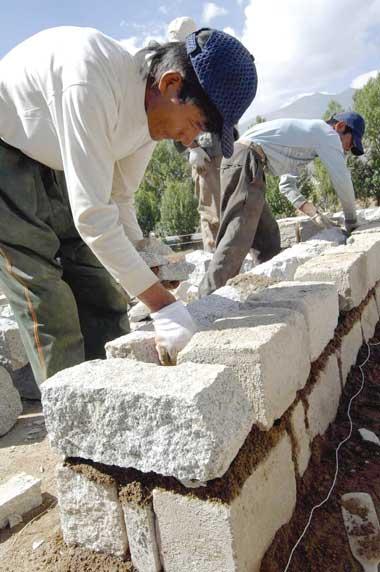
On June 20th,2006,farmers in Yamda Township of Tohlung Dechen County are busy for building their new houses.
Dronggo Village of Puqu Township in Nyingchi County is close to Nyang River. When the rainy season comes, the river floods. It severely disrupts the daily lives of the local people. Under the program of building new village socialism, the county government earmarked 4.6 million Yuan to move the whole Dronggo Village to a safer place. The government built a 1100 meter - long road around the village, and provided water drainage and electricity. Funds ranging from 25-35 thousand were allocated to villagers for resettling in their new houses. Tashi Nyima, a villager, said: "In the old Tibet, the Karxia Government never cared for our lives, but the new government makes things different for us and we could be living in a more wonderful house than we ever dreamed of. Our lives get better and better".
Aiming to increase the incomes of Tibetans in the process of construction of the new socialism villages, the local government not only provides consultation services but also provides advice that result in a surge of opportunities for farmers and herders to make income. Dinga Village in Bayi Downtown of Nyingchi County is famous as the "housand Yuan Village" This year, the total area of vegetable planting covered 601 mu, accounting for 96.9% of the villages cultivated land. The village also developed its specialties in of aquatic breeding and the transport business. From January to October, the total revenue is predicted to be 2.88 million Yuan, and per capita income is 11,817 Yuan, including a cash income of 7,681 Yuan.
Construction of the new socialist villages inspires a change of ideology for farmers and herders. Through the experience of the comfortable housing project, a big change in the living standards of Tibetans has happened, in tandem with improvements in the quality of life. Farmers and herders have developed an awareness of self-sufficiency and they believe that hard work will bring them a comfortable life. They are enthusiastically improving production, contributing wholeheartedly to their own lift in lifestyle, rather than only pray for help from Buddha. As their knowledge and technological skills increase, they pay less attention to drinking and fighting. More and more people are starting to move out to find jobs or do business, and only few prefer to only stay in home. All their houses look brand new, and they all pursue a healthy and civilized life style.
Happy Lives Aid Development
Within one year of the implementation of the comfortable housing project, one concept has permeated throughout the project process; i.e. comfortable housing can make happy lives, but happy lives can increase development.
In 2006, the housing project became the avenue by which Shigatse Prefecture determined to advance the new socialist villages. The prefecture government plans to construct 9,206 houses and 90 village administrative offices. By the end of October, 7,463 houses over 18 counties have already been constructed, accounting for 93% of the total in the Tibet Autonomous Region. By the end of November the rest of the houses are planned to be accomplished.
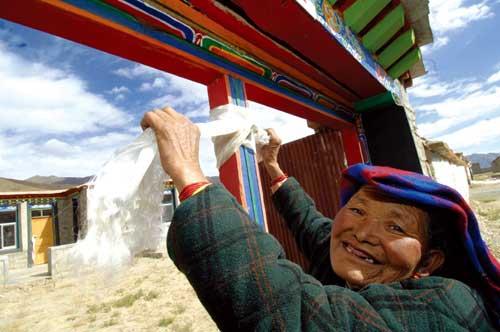
On Nov 2nd,2006,Tsering Drola,a sufferer of Keshin Beck Diseases in Nyinmo County,is hanging Hada(white silk scarf) on the entrance of her new house.The government sponsors about 10 million Yuan to build up 100 stone and wood mixed houses for those sufferers of Keshin Beck Diseases by moving away from unhealthy water source.
In 2006, per household income in Shigatse was estimated as 2,227 Yuan. There are 12,038 households of which per capita net income surpasses 4,000 Yuan, accounting for 11% of the total households. The Shigatse Government adopted four strategies with the aim of making an increase of farmers' and headsmen' income possible. The first is to adjust the structure of agricultural and animal husbandry including promoting reproduction, producing fertilizers, natural feeding under warm weather condition, increasing the number of Yaks but decreasing sheep, increasing the variety of cows, special feeding of domestic animals, and planting vegetables in green houses. The second is to encourage farmers and herders to seek jobs outside their homes, in tandem with providing technology training programs, information and opportunities for them. From January to September a total of 158.7 thousand people found work and business outside this prefecture, with a total income of 355 million. The third is that the mineral and service industry presents a wonderful marketing opportunity. The government of Shigatse actively encouraged farmers and herders to cater for tourism, which has possibly big market. The government supports tourist attractions in many ways and encouraged Tibetans living close to the arteries of transportation, to set up home-based hotels in their houses. Lastly, training programs were designed to enhance vocational education amongst farmers and herders. These programs have enhanced the capacity of farmers and herdsmen to use technology effectively.
Aiming to develop not only comfortable housing but also to improve the lifestyle of Tibetan farmers and herdsmen, the government of Nyingchi Prefecture consistently takes the "apply lives" as the aim while fulfilling its comfortable housing project. On one hand, the locations of comfortable housing are being turned into tourist attractions. The Chong Village in Kongpo Gyamda County takes advantage of being adjacent to the national road to run a business of farmhouse service and employs 20 farmers. Their yearly total incomes per capita, based on the original 2,800 Yuan incomes, are 450 Yuan. On the other hand, the government turns the comfortable houses into locations for raw product processing. Pachung Village of Zhamog Township in Pome County sets up a timber processing workshop at the location of the comfortable housing project, which actually attracts more than 20 villagers to work there and per capital yearly income adds up to 3,500 Yuan.
Taking advantage of favorable weather, thick forests with a big percentage of land coverage, rich forest-related resources, and high marketing potential of its tourist industry, Nyingchi Prefecture's government actively creates opportunities for farmers and herders in order to add to their income. The actual results are remarkable. It is estimated, in 2006, that per capita net income of farmers and herders in Nyingchi Prefecture will reach 3,150 Yuan, ranked as the top per capita income in the whole of Tibet. In addition, the government there studiously develops its major products, including feeding Tibetan pigs and chickens, planting herbal medicines, vegetable cultivation, advanced fruit production, processing of dry fruits, and so forth. Moreover, the government boosts special support to several leading enterprises, including 10 prefecture-level enterprises, 14 county level enterprises, and three Tibetan medicine and pharmacology enterprises. Promoting economic cooperative organizations, individual farmers and herdsmen tend to systemization in business. Currently, there are in total 38 economic cooperative organizations and various associations. To strengthen training programs for farmers and herdsmen and enhance the export of labor to outside the county and prefecture is another strategy of local government to improve people's incomes. From January to September, labor income reaches 50 millions in total, and per capita labor income reaches 1,600 Yuan.
Comfortable housing is one thing, but having happy lives is another. The comfortable housing project of Tibet has involved all Tibetans. What is expected is that, in 2007, Tibet is planning to advance its comfortable housing project in order to involve all farmers and herdsmen to enjoy this "welfare project". It plans to carry out construction of 52,112 houses for households, including 34,247 houses for renovation, 4,004 houses to house nomads, 7,640 houses for transfer, 5,000 houses for border residents, and 1,221 houses for moving people from areas of prevailing endemic diseases. In addition, the government also plans to construct recreational buildings and infrastructure for 600 administrative villages as the accompanying project with the comfortable housing project.

